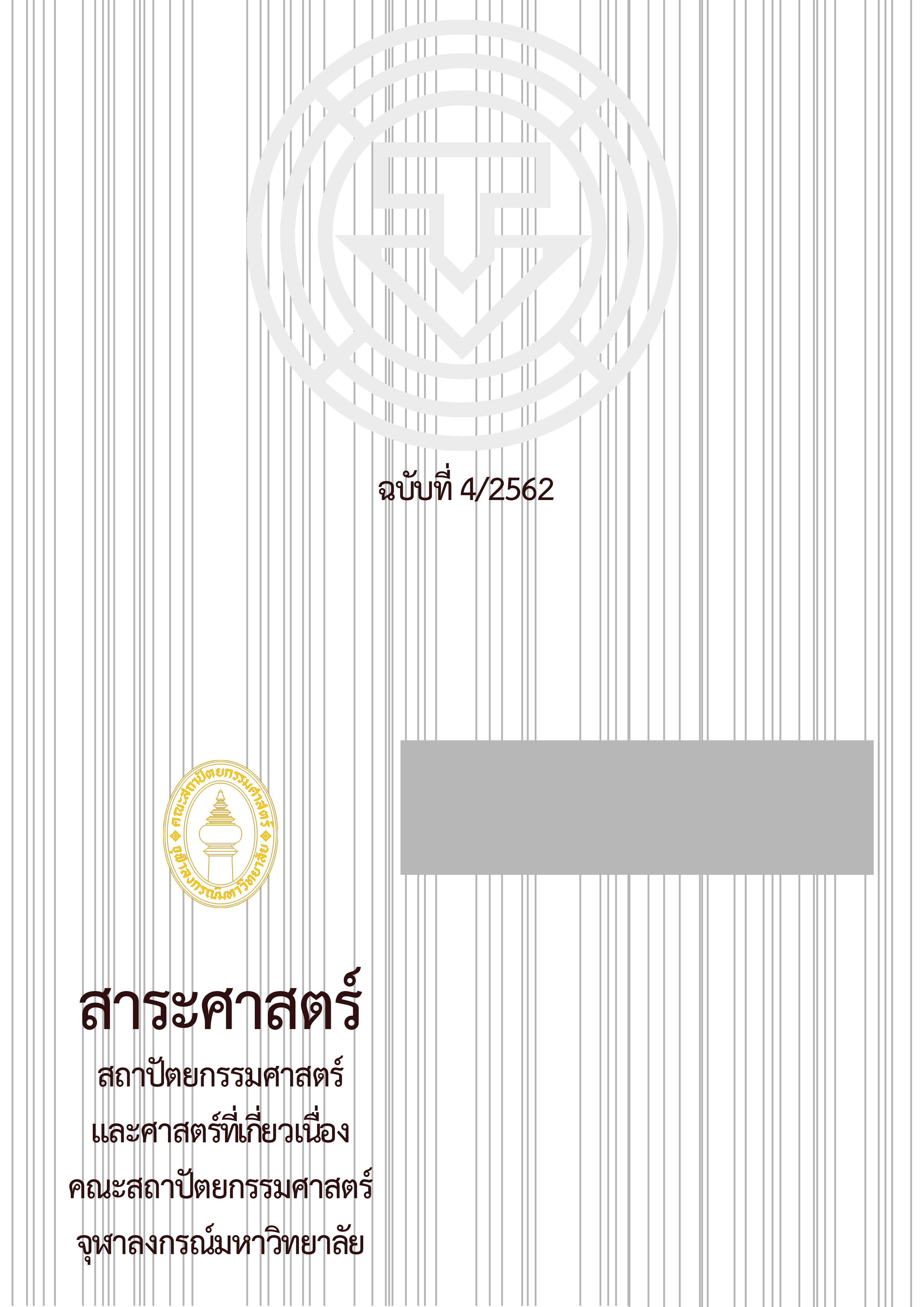The Physical Factors Affect to Location of Small Tourist Accommodations in Rattanakosin Area
Main Article Content
Abstract
The article explored the physical factors which affect small tourist accommodation development in the Rattanakosin area. The study combined spatial data and result of tourist accommodation owners in-depth interview by using Potential Surface Analysis (PSA), which is the analysis technical of the potential location from Geographic Information System tools (GIS). The factors which used for analysis are the location of a tourist information center, communities, community shops, tourist attraction, main road, convenient store, public transport, crime spots, and subway. The physical analysis results found the communities and community shops affected small tourist accommodation development. While most accommodation owners replied tourist attraction, public transport, crime spots, community shops and communities were affecting to decision location such as Chana Songkhram, Talat Yot, Bowon Niwet, San Chaopho Suea and Samran Rat sub districts.These results will give trend of the small tourist accommodation development in the Rattanakosin area .
Article Details
References
Ashworth, G.J. and J.E. Tunbridge. The Tourist-Historic City Retrospect and Prospect of Managing the Heritage City. New York: Routledge Taylor and Francis Group, 1990.
Bunda, R. B. “The Business of Beds: An Exploration of Hotel and Hostel Business Strategy.” Honors Scholar Thesis, University of Connecticut, 2014.
Choewit Pongsermpol and Prapatpong Upala. “Impacts of adaptive reuse of Heritage Building to Small Hotel Buildings in Bangkok.” Environment Behavior Proceedings Journal 5 (2017): 449-458.
Chou, T. Y., C.L. Hsu and M. C., Chen. “A Fuzzy Multi-Criteria Decision Model for International Tourist Hotel's Location Selection.” International Journal of Hospitality Management 27, 2 (2008:, 293-301. Accessed September 30, 2017. doi:10.1016/j.ijhm.2007.07.029.
Egan, D. J. and K., Nield. “Towards a Theory of Intraurban Hotel Location.” UrbanStudies (2000): 37.
Gunasekaran, N., and V. Anandkumar. “Factors of Influence in Choosing AlternativeAccommodation: A Study with Reference to Pondicherry, A Coastal Heritage.” Procedia-Social and Behavioral Sciences 62 (October 2012): 1127-1132.
Gray, W. S. and Liguori, S. C. Hotel and Motel Management and Operations. Englewood Cliffs, N.J.: Prentice-Hall, 1980.
Han, Heesup, Li-Tzang Hsu and Jin-Soo Lee. “Empirical Investigation of the Roles of Attitudes toward Green Behaviors, Overall Image, Gender and Age in Hotel Customers Eco-Friendly Decision-Making Process.” International Journal of Hospitality Management 28, 4 (2009): 519-528.
Issahaku, A. and E. A. Francis. “Dimensions of Hotel Location in the Kumasi Metropolis Ghana.” Tourism Management Perspectives 8 (2013): 1-8.
Manat Srivanit and Pattamon Selanon. “GIS-Based Land Suitability Analysis to Support Transit Oriented Development (TOD) Master Plan: A Case Study of the Campus Station of Thammasat University and Its Surrounding Communities.” BUILT: International Journal of Building, Urban, Interior and LandscapeTechnology 9 (2017): 49-60.
Mastercard Global Destinations Cities index 2016. “Global Top 20 Destination Cities Expenditure Breakdown.” สืบค้น 23 พฤศจิกายน 2560. https://newsroom.mastercard.com/wp-content/uploads/2016/09/FINAL-Global-Destination-Cities-Index-Report.pdf.
Moshabaki, A. and Akhlagh, E.M. “Designing the Policy in Order to Tourism Marketing in Iran: Tourism Development in Small Islands Across the World.” Geografiska Annaler (2004): 85.
UNESCO. “World Heritage Journeys of Buddhist Heritage Sites.” Accessed October 29, 2017.
https://whc.unesco.org/en/activities/955/.
Xiaojin Liang and Yaolin Liu. “The Effects of Locational Factors on the Housing Prices of Residential Communities: The Case of Ningbo China.” Habitat International 81 (2018): 1-11.
Yang Yan, Jingyin Tang. “How Location Evaluation: A Combination of Machine Learning Tools and Web GIS.” International Journal of Hospitality Management 47 (2015): 14-24.
Yang Yang and Kevin K.F. Wong. “How Do Hotels Choose Their Location? Evidence? From Hotels in Beijing.” International Journal of Hospitality Management 31 (2012): 675-685.
Yang, Y., Wong, K. K. F. and Wang, T. K. “How Do Hotels Choose Their Location? Evidence from Hotels in Beijing.” International journal of hospitality management 31(3): 675-685.
“กฎกระทรวง เรื่อง กำหนดลักษณะอาคารประเภทอื่นที่ใช้ประกอบธุรกิจโรงแรม.” ราชกิจจานุเบกษา. เล่ม 133 ตอนที่ 72
ก หน้า 8-12. (2559, 19 สิงหาคม).
สำนักผังเมือง กรุงเทพมหานคร. กองนโยบายและแผนงาน. “รายงาน: การศึกษาจำนวนนักท่องเที่ยวและนักทัศนาจรใน
เขตกรุงเทพมหานคร ปีพ.ศ.2559.” สืบค้น 30 สิงหาคม 2560. http://cpd.bangkok.go.th:90/web2/SAT/0361.pdf.
สุภัทธา สุขชู. “Boutique Hotel Generation โรงแรมบูติก จากวันวาน ถึงวันนี้.” สืบค้น 30 สิงหาคม 2560.
https://positioningmag.com/6621.
ยงธนิศร์ พิมลเสถียร. การปรับปรุงฟื้นฟูเมืองและการอนุรักษ์เมือง. ปทุมธานี: สำนักพิมพ์มหาวิทยาลัยธรรมศาสตร์, 2555.
เยาวลักษณ์ จันทมาศ. “การวางผังเมืองและการปรับตัวกับสภาพการเปลี่ยนแปลงภูมิอากาส: กรณีศึกษาน้ำท่วมใน
จังหวัดปทุมธานี.” วิทยานิพนธ์ปริญญามหาบัณฑิต จุฬาลงกรณ์มหาวิทยาลัย, 2559.
Ekkarach Laksanasamrith. “สถาปนิกพลิกฟื้น คืนความสุขให้ถิ่นเกิดที่บ้านไร่ไออรุณ.” สืบค้น 30 สิงหาคม 2560.
https://dsignsomething.com/2015/12/01/สถาปนิกพลิกฟื้น-คืนความ/.


